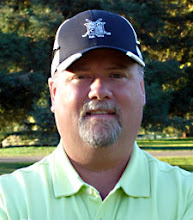Sunday, October 23, 2011
Cart Path Edging
Our detail work has taken a back seat to the rest of our fall maintenance practices. Trees are not weedeated as well as usual, planter beds contain a few weeds, shoe spike brushes need cleaning or replacement, and the cart paths need a hair cut. Now that all the heavy lifting is done, we are turning focus to the detail work that gives a course that 'manicured' look that we've been lacking for the past few weeks.
In the photo above is Izzo acting as the pilot car for Bert on the Toro sand rake. This old unit has been converted into a cart path edger with a small hydraulic arm and a plow disc called "Edge-It." I don't know if these are still in production, but it does a wonderful job. Ours had been worked over pretty hard and needing some welding repairs to keep going. The last time we edged all the paths was back in August when the unit cracked under the pressure.
To make this a quicker job using less people, Bert has used some ingenuity to make the edging process a one man show. He has fashioned an old rake handle to be a scraper and runs that adjacent to the edging disk. Behind him, a Lesco blower removes the debris from the path. It isn't turned on in this particular photo because we don't want the debris in the fairway and will pick it up off the path. When he turns the corner, he will blow the spoils into the rough to be picked up by our sweeper.
The whole process takes three or four afternoons following the usual morning assignments.
Tuesday, October 11, 2011
Risk and Reward
The tenth hole has gone through its fair share of changes over the years, and it's time for another one. So far, we've grown in a lake buffer zone, transitioned to an all-bermuda fairway, removed a few trees, and planted a few more. Now the contour of fairway/rough will change slightly to make the hole a little more interesting.
Today, you still have that option, but the better line is straight for the green, right along the water's edge. To encourage the risky shot, we've removed the trees that used to block the view of the green, we expanded the fairway on the left, and now we are bringing in the rough on the right side.
For now, the fairway will shrink by 15 yards near the 150 yard marker. We've also planted 3 cork oak trees to penalize the safe shots that go a little too far to the right. These changes are intended to make this hole more interesting and thought provoking. Think twice next time you take aim at the palm tree and shoot for safety. It's not as safe as it used to be.
Thursday, October 6, 2011
Fall maintenance photos
 |
Bert is seeding the approaches with Izzo keeping a watchful eye. We slit seeded the tees and approaches in two directions and then broadcast more seed to be brushed into the canopy.
|
Subscribe to:
Posts (Atom)







